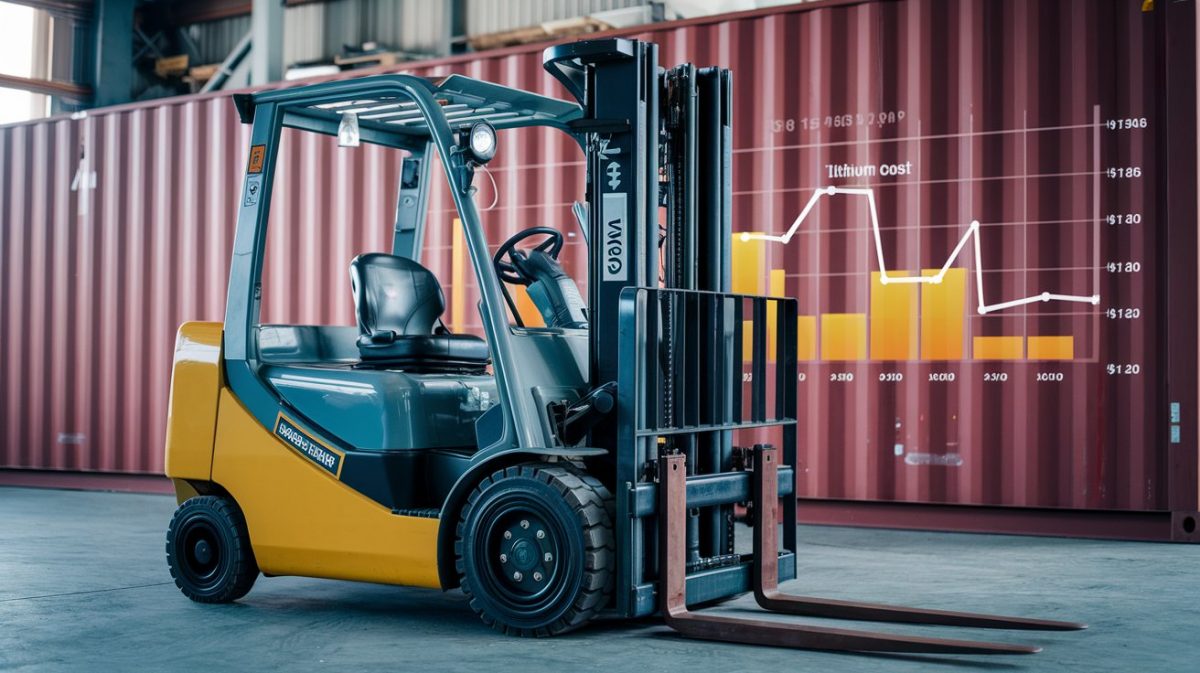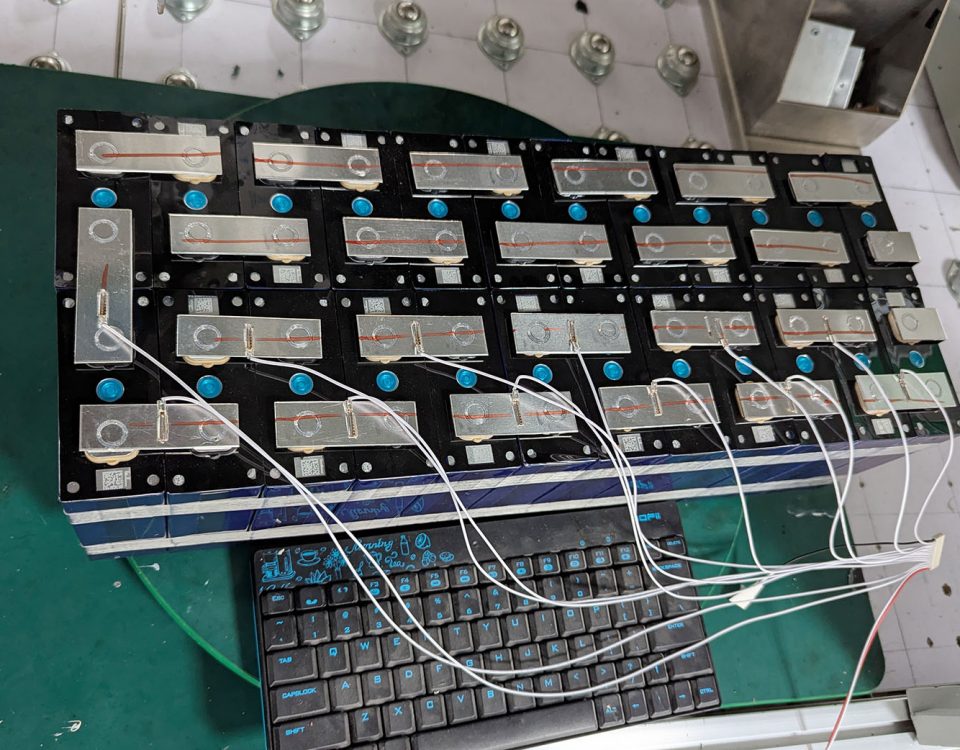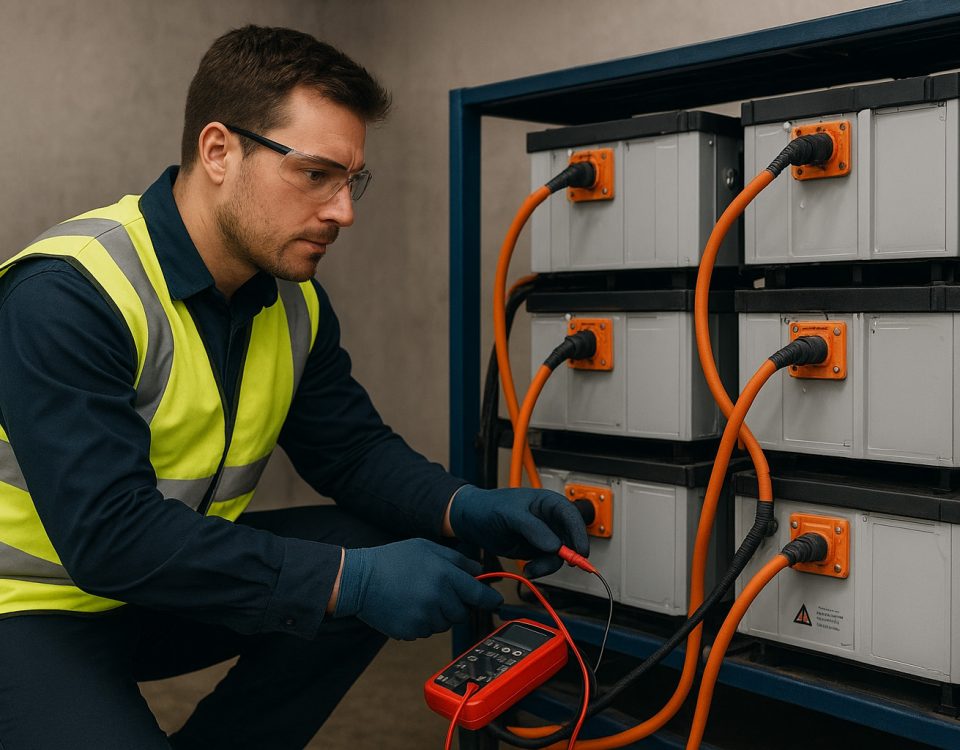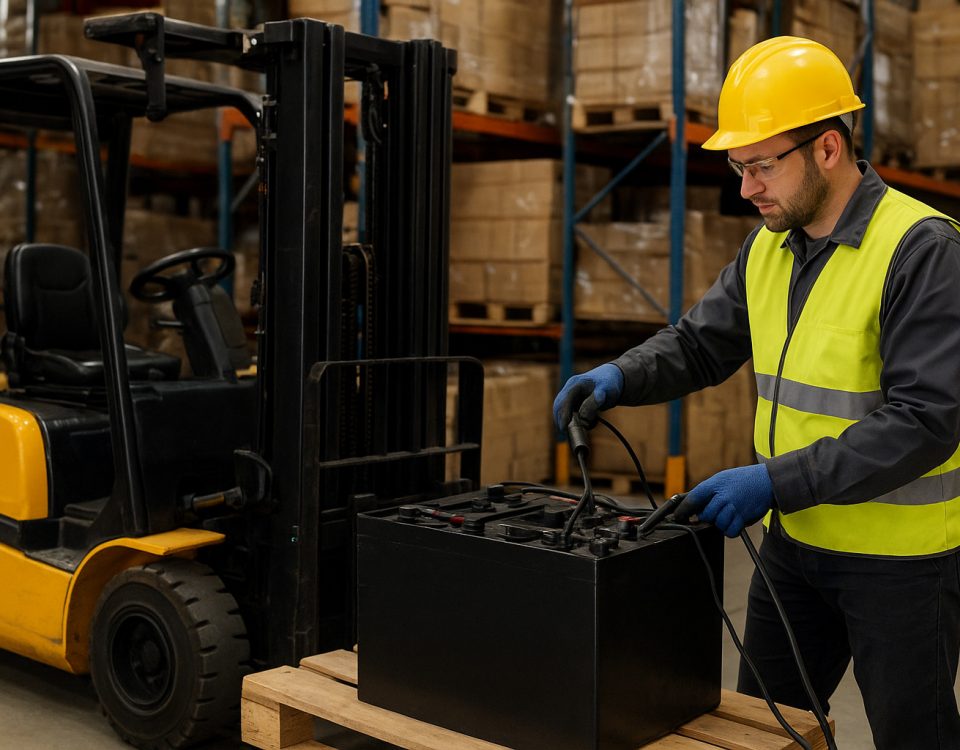Trong những năm gần đây, việc áp dụng Lithium sắt photphat (LiFePO₄) Pin trong các phương tiện công nghiệp, đặc biệt là xe nâng điệnđã tăng trưởng đáng kể. Sự chuyển đổi này được thúc đẩy bởi tiềm năng tiết kiệm chi phí, hiệu suất cao hơn và hiệu quả hoạt động tốt hơn. Mặc dù chi phí ban đầu của pin LiFePO4 có thể cao hơn so với pin chì-axit truyền thống, nhưng chúng Tổng chi phí sở hữu (TCO) Trong suốt vòng đời của xe nâng, việc sử dụng pin LiFePO4 mang lại hiệu quả kinh tế cao hơn nhiều. Trong bài viết này, chúng ta sẽ phân tích tính hiệu quả về chi phí của pin LiFePO4 trong xe nâng điện, khám phá các khía cạnh như: Chi phí ban đầu và chi phí dài hạn, Chi phí trong suốt vòng đời, Giảm thời gian ngừng hoạt động, Và Các nghiên cứu trường hợp thực tế trong ngành công nghiệp để minh họa cách các doanh nghiệp có thể tận dụng công nghệ tiên tiến này.
Chi phí ban đầu so với chi phí dài hạn: Hiểu rõ sự đánh đổi tài chính
Khi đánh giá việc sử dụng Pin LiFePO4 Trong xe nâng điện, Đầu tư ban đầu là một trong những vấn đề chính mà các nhà quản lý đội xe phải đối mặt. Các loại pin này thường có chi phí ban đầu cao hơn so với pin axit chìTuy nhiên, điều quan trọng là phải xem xét Lợi ích tài chính lâu dài đi kèm với khoản đầu tư ban đầu này.
Pin LiFePO4 tự hào có tuổi thọ dài hơn, đòi hỏi ít phải thay thế hơn theo thời gian. Trung bình, các loại pin này có thể sử dụng được lên đến 5.000 chu kỳ hoặc lâu hơn, vượt trội so với ắc quy chì-axit, thường có tuổi thọ khoảng 1.500 chu kỳ. Điều này tuổi thọ dài hơn được dịch thành một Giảm tổng chi phí sở hữu (TCO) Trong suốt thời gian sử dụng của xe nâng, ngay cả khi chi phí ban đầu cao hơn.
Ngoài ra, pin LiFePO4 yêu cầu nhiều Ít bảo trì so với ắc quy chì-axit. Ắc quy chì-axit cần được bảo dưỡng định kỳ. Nạp nước, Sạc cân bằng, Và theo dõi của mức axit. Ngược lại, pin LiFePO4 có yêu cầu bảo trì tối thiểu, giúp giảm thêm chi phí liên quan đến lao động Và thời gian ngừng hoạt động. Điều này Khía cạnh tiết kiệm chi phí Các chi phí này có thể tích lũy theo thời gian, khiến LiFePO4 trở thành lựa chọn kinh tế hơn cho đội xe nâng.
Chi phí trọn đời: Pin LiFePO4 so với pin chì-axit
So sánh giữa pin LiFePO4 và pin chì-axit thường tập trung vào Chi phí trong suốt vòng đờiMặc dù ắc quy chì-axit có giá thành ban đầu thấp hơn, nhưng chúng tiêu tốn nhiều chi phí hơn. Chi phí bảo trì Và tuổi thọ ngắn hơn, điều này có thể làm tăng đáng kể tổng chi phí theo thời gian.
-
Pin LiFePO4Như đã đề cập, các loại pin này có thể sử dụng được trong thời gian dài. lên đến 5.000 chu kỳ và thường đi kèm với bảo hành của 5 đến 7 nămTrong suốt vòng đời của một xe nâng điện, sự chênh lệch giá ban đầu giữa pin LiFePO4 và pin chì-axit có thể được bù đắp bởi tuổi thọ kéo dài, ít phải thay thế hơn và chi phí bảo trì thấp hơn. Chi phí trên mỗi chu kỳ Điện áp của pin LiFePO4 thấp hơn đáng kể so với pin chì-axit.
-
Pin axit chì: Ắc quy chì-axit thường có tuổi thọ 1.500 chu kỳ trước khi yêu cầu thay thế, với bảo trì Và Chi phí sửa chữa gây thêm gánh nặng tài chính chung. Một xe nâng sử dụng ắc quy chì-axit có thể yêu cầu thay thế nhiều lần Trong cùng khoảng thời gian mà pin LiFePO4 vẫn hoạt động, dẫn đến việc tiêu thụ năng lượng cao hơn. Chi phí trong suốt vòng đời.
Khi so sánh hai loại pin, Tiết kiệm chi phí Việc sử dụng pin LiFePO4 trở nên rõ ràng qua thời gian hoạt động dài. Với tần suất thay thế ít hơn và giảm thiểu bảo trì Chi phí, pin LiFePO4 giúp giảm đáng kể chi phí tổng thể của Sở hữu pin.
Giảm thời gian ngừng hoạt động: Tác động của sạc nhanh và bảo trì tối thiểu
Một lợi thế đáng kể khác của Pin LiFePO4 khả năng của họ trong việc giảm thiểu thời gian ngừng hoạt động, một yếu tố quan trọng trong hiệu quả của bất kỳ Hoạt động của xe nângThời gian ngừng hoạt động thường do Số lần sạc pin và nhu cầu về bảo trì.
-
Sạc nhanh hơnPin LiFePO4 có thể sạc nhanh hơn pin chì-axit, thường chỉ cần sạc trong thời gian ngắn. 1,5 đến 2 giờ để sạc đầy. Điều này cho phép sử dụng lâu hơn. Giờ làm việc mỗi ngày, với ít gián đoạn nhất đối với quy trình làm việc. Ngược lại, ắc quy chì-axit thường yêu cầu 8 đến 10 giờ Để sạc đầy. Với sạc nhanhXe nâng được trang bị pin LiFePO4 có thể trở lại hoạt động nhanh hơn, tối đa hóa năng suất.
-
Bảo trì tối thiểuPin LiFePO4 yêu cầu ít bảo trì hơn nhiều. Điều này có nghĩa là Ít cuộc gọi dịch vụ hơn và giảm thiểu công sức dành cho việc kiểm tra và bảo dưỡng pin. Điều này không chỉ giúp giảm chi phí vận hành mà còn hạn chế Thời gian ngừng hoạt động của thiết bịĐảm bảo rằng xe nâng hoạt động trong thời gian dài hơn trong suốt cả ngày.
Bằng cách loại bỏ nhu cầu phải thực hiện định kỳ Kiểm tra bảo dưỡng và giảm thiểu Thời gian sạc lạiCác doanh nghiệp có thể tăng cường đáng kể Nâng cao hiệu quả hoạt động Và Giảm thời gian ngừng hoạt động, điều này có tác động trực tiếp đến lợi nhuận ròng.
Các trường hợp điển hình trong ngành: Tiết kiệm chi phí và nâng cao hiệu quả trong thực tế
Một số tài xế xe nâng đã nhận ra rằng Tiết kiệm chi phí Và Cải thiện hiệu suất Các pin LiFePO4 mang lại cho hoạt động của họ. Dưới đây là hai ví dụ:
-
Trường hợp nghiên cứu 1: Công ty kho bãi quy mô lớn Một công ty kho bãi lớn đã chuyển đổi toàn bộ đội xe nâng của mình từ ắc quy chì-axit sang ắc quy LiFePO4. Trong quá trình 3 năm, công ty đã ghi nhận một Giảm chi phí bảo trì 30% và một tăng năng suất do Sạc nhanh hơn Thời gian sử dụng của pin LiFePO4. Công ty cũng đã hưởng lợi từ tuổi thọ dài hơn của các pin, điều này có nghĩa là ít phải thay thế hơn và chi phí thấp hơn. Tổng chi phí sở hữu Trong dài hạn. Việc chuyển sang sử dụng pin LiFePO4 đã giúp công ty đạt được những kết quả đáng kể. Tiết kiệm chi phí Trong khi nâng cao hiệu quả hoạt động.
-
Trường hợp nghiên cứu 2: Trung tâm phân phối Một trung tâm phân phối có 50 xe nâng điện đã thay thế ắc quy chì-axit bằng ắc quy LiFePO4. Sau khi chuyển đổi, công ty đã báo cáo rằng... Giảm 25% chi phí năng lượng do sự cải thiện Hiệu suất sạc của các pin LiFePO4. Ngoài ra, trung tâm phân phối đã gặp phải một Giảm thời gian ngừng hoạt động 30%, vì các xe nâng có thể hoạt động liên tục trong thời gian dài hơn và sạc pin nhanh hơn. Nhìn chung, trung tâm đã ghi nhận sự cải thiện đáng kể về cả hai mặt. năng suất Và hiệu quả chi phí.
Các nghiên cứu trường hợp này minh họa những lợi ích thực tế mà các công ty trong ngành kho bãi và phân phối có thể đạt được khi áp dụng pin LiFePO4. Bằng cách Giảm thời gian ngừng hoạt động, Giảm chi phí bảo trìvà tận dụng lợi thế của tuổi thọ cao Với pin LiFePO4, các doanh nghiệp có thể đạt được lợi nhuận đầu tư đáng kể.
RICHYE: Đối tác đáng tin cậy trong các giải pháp pin Lithium
RICHYE là nhà sản xuất pin lithium chuyên nghiệp, chuyên sản xuất pin LiFePO4 chất lượng cao. Nổi tiếng với... Hiệu suất xuất sắc, an toàn, Và độ tin cậyPin lithium của RICHYE là lựa chọn lý tưởng cho các ứng dụng xe nâng điện. Với hơn một thập kỷ kinh nghiệm trong ngành, RICHYE đã trở thành nhà cung cấp đáng tin cậy cho các doanh nghiệp mong muốn nâng cao hiệu quả, giảm chi phí và góp phần vào các thực hành bền vững.
Bằng cách lựa chọn pin LiFePO4 của RICHYE, các doanh nghiệp sẽ được hưởng lợi từ sản phẩm chất lượng cao đề xuất Hiệu suất bền bỉ Và Tiết kiệm chi phíVới cam kết hướng tới sự xuất sắc, RICHYE là đối tác đáng tin cậy của bạn trong việc phát triển các giải pháp năng lượng sạch và tối ưu hóa hoạt động của xe nâng.
Phần kết luận
Trong khi chi phí ban đầu của Pin LiFePO4 Đối với xe nâng điện, chi phí có thể cao hơn so với ắc quy chì-axit, Lợi ích lâu dài là rõ ràng. Từ Giảm tổng chi phí sở hữu để Thời gian sạc nhanh hơn, tuổi thọ dài hơn, Và Giảm thời gian ngừng hoạt động, Pin LiFePO4 mang lại tiết kiệm chi phí đáng kể và hiệu suất được cải thiện. Như đã được chứng minh qua các nghiên cứu trường hợp thực tế, việc chuyển sang sử dụng pin LiFePO4 đã dẫn đến Tăng năng suất Và Giảm chi phí hoạt động cho các doanh nghiệp trong các ngành nghề khác nhau.
Đối với các công ty đang tìm kiếm Tối ưu hóa hoạt động của xe nâng, giảm chi phívà đón nhận Giải pháp năng lượng bền vững, áp dụng Pin LiFePO4 là một lựa chọn tiên phong mang lại lợi ích lâu dài.




